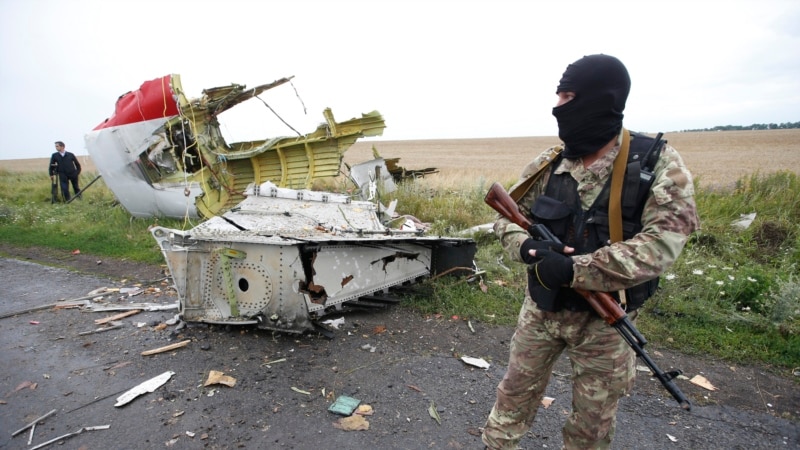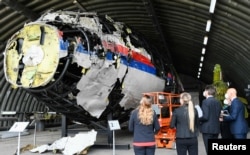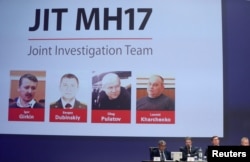Russia’s Attempt to Link Il-76 and MH17: Smart Disinfo or Self-Incrimination?
In a large-scale disinformation campaign to discredit Ukraine, Moscow is tying the recent crash of an Il-76 military transport plane over the Belgorod region, which borders Ukraine, to the 2014 downing of Malaysia Airlines flight MH17 over eastern Ukraine.
Russia says Ukraine shot down the Il-76 and claims 74 people were on board, including 65 Ukrainian prisoners of war. Ukraine has neither confirmed nor denied it fired on the plane.
Russia made public a few video clips of the crash site showing some severed body parts. Kyiv contends Moscow has yet to present evidence 65 Ukrainian POWs died in the crash.
[embedded content]
Ukraine has countered Russian accusations with a demand for an international investigation. Moscow, however, has not permitted independent and Ukrainian investigators access to the crash scene. Ukraine says Moscow is blocking an international investigation.
As part of a large-scale propaganda attack that Moscow launched against Ukraine after the Il-76 downing, Russia linked the Il-76 crash to MH17, resurrecting its old, thoroughly debunked disinformation that Ukraine shot down that passenger airliner nearly a decade ago.
“In 2014, the Bandera junta in Kiev downed #Malaysian flight #MH17 over Donbass, taking almost 300 innocent lives,” the Russian Embassy in South Africa posted to X on January 26.
That is false.
The July 17, 2014, downing of MH17 resulted in the deaths of all 298 people on board, later identified as citizens of 10 nations. That made the crash subject to several multinational investigations, which became unified, creating a Joint Investigative Team.
The court in the Netherlands examined the evidence presented by that investigation between March 9, 2020, and November 7, 2022. It found guilty and sentenced in absentia two Russian citizens with links to the Russian intelligence service, and one Ukrainian citizen fighting with Russian-controlled forces in eastern Ukraine, to life in prison.
The court ruling left no room for doubt that that MH17 was shot down with a Russian Buk-TELAR missile system delivered by the Russian Army’s 53rd Anti-Aircraft Missile Brigade to a region of Ukraine controlled by Russia-controlled forces.
Since the downing of MH17, Russia put out myriad false narratives trying to white wash its own role and falsely implicate Ukraine.
Scores of international fact checkers and investigative journalists, including Polygraph.info, have repeatedly exposed and debunked Russian disinformation about MH17.
Moscow’s attempts to deflect blame for shooting down MH17, particularly within the context of Russia’s clandestine invasion of Ukraine in 2014, became a case study in the Kremlin’s so-called firehose of falsehoods propaganda model. It involves disseminating numerous and often competing narratives intended to overwhelm and confuse the audience rather than convince them of any one truth.
The majority of the 298 people killed in the crash of MH17, which was flying from Amsterdam, the Netherlands, to Kuala Lumpur, Malaysia, were Dutch.
The Dutch Safety Board, a Hague-based body that investigates safety concerns in the Netherlands, conducted three investigations into the downing of flight MH17.
The Dutch Safety Board established that a 9N314M warhead, carried by a Russian Buk surface-to-air missile system, caused the crash of MH17.
Investigators made that determination by studying the damage pattern on the plane’s wreckage, the missile fragments found in the aircraft as well as the bodies of victims, paint traces on the missile fragments and parts of a recovered missile, and the way the plane broke up.
The Dutch investigators said they “investigated and excluded” theories put forward by Russia or pro-Russia sources, including that an air-to-air missile downed MH17, or that an explosion inside the plane caused it to crash.
A separate international criminal investigation known as the MH17 Joint Investigation Team (JIT) was conducted jointly by the Netherlands, Australia, Malaysia, Belgium and Ukraine, in conjunction with the Dutch Safety Board investigation.
The JIT was able to compile a number of key features about the system used to down MH17, which it described as a “fingerprint.”
Those features included a center of gravity mark, white marks and damage on the side skirts of the vehicle, missing spokes on the Buk’s second wheel, a railway transport mark, and fragments of unit digits beginning with the Number 3.
Comparing that fingerprint with numerous Buk systems, “both Ukrainian and Russian ones,” the JIT found the system used to shoot down MH17 matched that of the Buk system, which was carried by the Russian Army’s 53rd Anti-Aircraft Missile Brigade from the city of Kursk.
The JIT also investigated the plane’s wreckage, missile fragments and human remains, as well as relevant radar, satellite images and telecom data, including intercepted telephone conversations, to reach their conclusions.
For example, the Dutch Safety Board and open source investigators verified and geolocated videos and photographs that showed a Buk missile launcher moving through several towns in Ukraine’s Donetsk region toward the location from which the missile was launched. Several hours later, the Buk system was seen heading back toward the Russian border — minus one missile.
Journalists from several international media outlets were able to verify the locations shown in those photos and videos in person.
Witnesses, including a journalist, also saw the Buk missile launcher carried across the border.
Based on that investigation, Dutch authorities tried four individuals with downing MH17. Three of them were Russian citizens – Igor Girkin, a former colonel in the Russian Federal Security Service (FSB) who took part in the invasion and annexation of Crimea; Sergei Dubinsky, a former officer in the Russian military intelligence service, or GRU; Oleg Pulatov, another ex-GRU officer. The fourth person tried, Leonid Kharchenko, was a Ukrainian citizen who fought with a Russian-directed separatist unit.
Dubinsky, Girkin and Kharchenko were convicted of downing MH17, while Pulatov was acquitted.
Intercepted phone calls also provided evidence that the Kremlin was directing activities in the so-called “Donetsk People’s Republic” (DNR) and “Luhansk People’s Republic” (LNR), breakaway regions of eastern Ukraine which have since been annexed by Russia.
In February 2023, the JIT concluded there were “strong indications” that Russian President Vladimir Putin signed off on supplying the Buk missile system to the Russia-controlled forces in eastern Ukraine. Dutch prosecutors said there was not yet enough concrete evidence “to lead to new prosecutions.”
On January 31, the International Court of Justice (ICJ), the U.N.’s top court, declined to rule on whether the Russian state was responsible for downing MH17, after ruling that Russia had breached the U.N.’s anti-terrorism treaty by not investigating credible allegations that Russian funds had been sent to Ukraine to potentially fund terrorist activities, Reuters reported.
However, the court did not rule on Russia’s culpability in the downing of MH17 due to technical reasons, because the complaint that Ukraine filed with the court against Russia was over ” terrorism financing,” which the court said only applies to monetary and financial support, not the provision of weapons or training.





